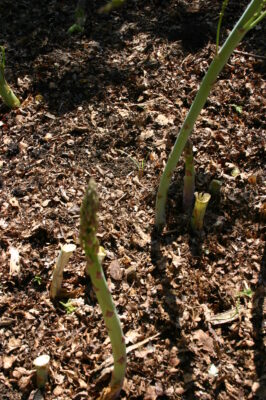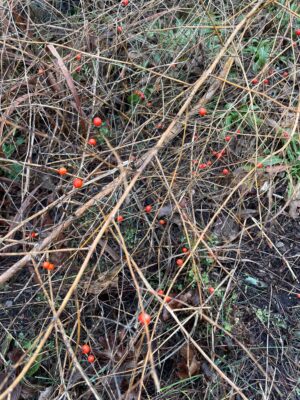
About twenty-five years ago I bought some asparagus roots, planted them and waited to enjoy the stalks. The bed has provided fresh asparagus since that time. Every year, I add more seaweed and well-rotted horse manure or compost to the bed and have been rewarded every spring with fresh asparagus. But now I find that the spears are becoming about as thick as my thumb, and some of the plants have migrated outside the growing bed.
Since we enjoy fresh asparagus, I decided to plant a new bed, but finding a supplier who could send fresh plants rather than plants that have been is storage for a few months (and in some cases, with rotted plants in the middle of the bundle), proved difficult.
The alternative is to start new plants from seeds. While this takes longer, it produces a large number of plants, that can be culled to provide the best spears. In general, a male plant produces more spears.
I also noticed stray plants appearing in different parts of the yard. These plants were probably distributed by birds that ate the berry seeds. These plants were dug up and set out in the new bed.
Female asparagus plants produce little red berries every fall. (A male plant must be near to pollinate the berries). I picked handfuls of little red berries off the existing ferns at the end of the summer season. These berries were then dried indoors and put into cold storage aka, the refrigerator for six- to eight-weeks
The berries were removed from the refrigerator and planted in trays in the greenhouse. It took about six to eight weeks for the berries to germinate. The plants were left in deep trays in the unheated greenhouse for an entire year. The ferns were rather spindly and were left to grow out. The second summer the plants were moved out of the trays and put in a new bed.

I prepared the bed by digging it out to about eighteen inches (about 0.5m) deep and laying about a foot (0.3m) of well-rotted horse manure, compost and seaweed in the bed, then covered it with a few inches of garden soil. The new plants were set on little mounds of soil with their roots spread out carefully. As soon as all the plants were set out, the entire bed was covered with a layer of compost, a layer of garden soil, and shredded straw mulch to keep weeds at bay.
The first year no stalks were harvested. The second year only a few stalks were taken, but in the third year I harvested all I wanted. I also set a few plants in the unheated greenhouse bed. These plants push up spears about three weeks to a month before the outdoor plants, giving me a longer growing (and eating) season. In general, I harvest spears for about six weeks, then the plants are left to grow into ferns until frost. After the first frost the ferns are cut back and composted.


